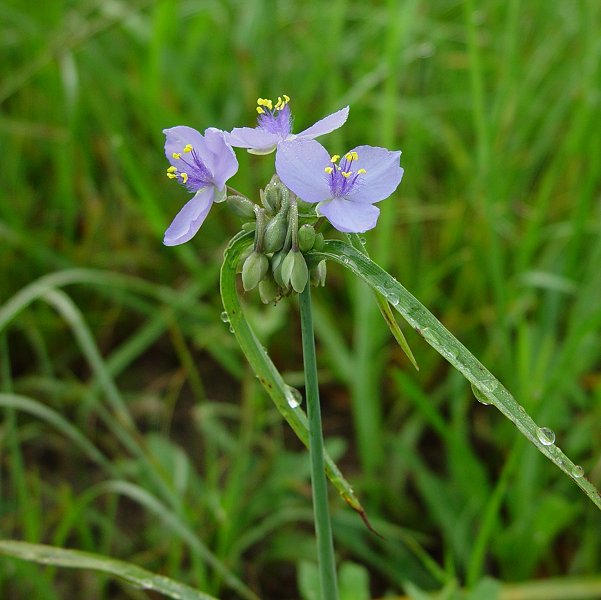Tradescantia ohiensis Raf.
Smooth Spiderwort

Native
CC = 3
CW = 3
MOC = 77
© DETenaglia
Tradescantia ohiensis Raf.Smooth Spiderwort | |
 |
Native CC = 3 CW = 3 MOC = 77 |
© DETenaglia |
|
Family - Commelinaceae Habit - Perennial forb, the roots fibrous or more commonly thickened and somewhat fleshy to tuberlike. Stems - Erect, to 1 m, unbranched, straight or sometimes slightly zigzag, glabrous or nearly so, glaucous.
Leaves - Alternate, linear, 4-45 cm long, flat above the base, mostly narrower than the sheaths, pale green to grayish green, glabrous, glaucous, clasping stem.
Inflorescence - Terminal, umbellate clusters, subtended by 1 or 2 bracts indistinguishable from the foliage leaves. Flower stalks 7-25 mm long, glabrous. Flowers usually open 1-3 at a time.
Flowers - Actinomorphic. Sepals 3, 8-15 mm long, narrowly ovate to elliptic, pale green or less commonly tinged with pale reddish pink, herbaceous, glabrous or with sparse, nonglandular hairs at the tips, glaucous. Petals 3, 8-20 mm long, equal and lacking stalklike, narrowed bases, broadly obovate to elliptic, blue to purple to pink. Stamens 6, the filaments with dense, spreading, multicellular hairs. Staminodes absent.
Fruits - Capsules 4-8 mm long, ovoid, 3-locular. Seeds 3-6 per capsule, 2-3 mm long, oblong to ovoid and somewhat flattened with a depression on 1 side, the surfaces undulate to bluntly several-ribbed.
Flowering - May - July. Habitat - Glades, upland prairies, upland forest openings, roadsides, fields, pastures, railroads. Origin - Native to the U.S. Lookalikes - Several other species of Tradescantia. Other info. - This species is sometimes mistaken for a grassy weed by beginners who are delighted to see it bloom. It is the most common species of the genus in Missouri, occurring statewide. Beyond Missouri its range extends throughout the U.S. Midwest, reaching the Atlantic coast in somewhat sparser fashion. The plant is easily recognized by its symmetric 3-parted flowers, which are ordinarily blue to purple, and its narrow, straplike leaves. It can be distinguished from its lookalikes by the narrow leaves, the width of the blade being less than the width of the flattened sheath, and by the glabrous and glaucous buds and sepals. These may occasionally bear a few sparse, nonglandular hairs. The stems are moderately succulent. Photographs taken in Gainesville, FL. 7-23-02, and at Busiek State Forest, MO., 6-16-05 (DETenaglia); also at Klondike County Park, St. Charles County, MO, 5-8-2010, Katy Trail near Augusta, St. Charles County, MO, 5-9-2012 and 5-12-2017, St. Joe State Park, St. Francois County, MO, 5-13-2015 and 5-21-2018, Shaw Nature Reserve, Franklin County, MO, 5-21-2015, and Al Foster Trail near Glencoe, St. Louis County, MO, 5-24-2018 (SRTurner). Thanks to KBildner for supplying seeds to photograph. |